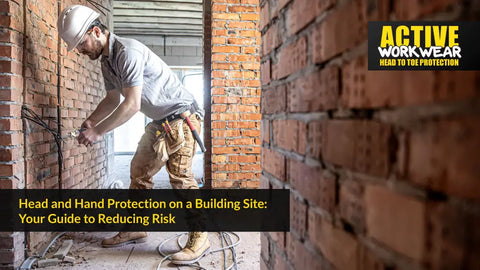Head and Hand Protection on a Building Site: Your Guide to Reducing Risk
- by Mike Johnson

Head and Hand Protection on a Building Site
When you think of construction sites, you probably picture a lot of heavy machinery, fast-paced action and noise. It’s obvious that in such a place, there is an elevated risk of injury among workers.
While most construction workers understand what they need to do to stay safe, every year, there are still new cases of injury from falling objects, flying debris and hazardous equipment due to the nature of the job. In fact, the construction industry is one of the highest-risk sectors for fatal injuries among all industries.
If you work or plan on working at a construction site or have friends or family who do, it’s important to note some basic safety precautions. Construction work involves many inherent risks that your average job probably doesn’t expose you to. Thankfully there are ways you can help minimise them.
In this blog post, we will discuss head and hand protection on a building site as well as other necessary protective gear and clothing every worker should be equipped with in order to stay safe while on the job.
Basics of Construction Site Safety
It’s important to note that construction site safety applies to everyone working in the area, not just those wearing hard hats or steel-toed boots. Workers in every aspect of the project, no matter what they’re doing, should follow standard safety practices.
When we talk about construction site safety, we are referring to the ways in which workers can minimise the risk of injury. Construction sites have many inherent risks that your average office job probably doesn’t expose you to. Thankfully there are ways you can help minimise them.
Eye and Ear Protection
Construction workers handle a variety of heavy machinery and work in environments that are extremely loud. Wearing proper protective gear, including earplugs or earmuffs, as well as protective eye gear, can significantly reduce the risk of injury on the job. While it’s true that wearing earplugs can make it more difficult to hear communication between workers, it’s important to remember that keeping one’s hearing intact is of paramount importance. The risk of hearing loss is present at all times during construction, but it is especially high during blasting. Wearing earplugs during blasting can greatly reduce the risk of hearing loss.
Hand Protection
Construction work involves a lot of heavy lifting and manual labour, so naturally, there is an elevated risk of injury to the hands. However, there are ways to minimise the risk. In many cases, construction workers wear gloves to protect their hands from cuts, scrapes, and abrasions.
While gloves do provide some protection, there are situations where they are not enough. Gloves are not enough for workers who are operating potentially dangerous machinery, handling or loading materials with nails or other protruding materials or working in areas where there is a risk of vibration or impact.
Hand protection is not only important to protect workers from injury but also to prevent the spread of infection. In areas where there is a risk of infection, workers should wear protective gloves. When choosing a glove, it’s important to make sure that it is the right fit. Gloves that are too loose can be a hazard, particularly when operating machinery.
Footwear
Footwear is one of the most important pieces of construction site gear. The feet bear the brunt of wear and tear on the job site and are susceptible to a wide range of hazards. Working in areas with mud, water, sharp objects, and other hazards can easily result in serious foot injuries and infections.
If you’re working in a location with a lot of foot traffic and there is the potential for slipping and falling, wearing appropriate footwear can help prevent injuries. When purchasing footwear for the job site, it’s important to choose the right type of boot. For example, if you’re working on a building site and will be walking around concrete and asphalt, you’ll want to wear a boot that’s tough enough to protect your feet from the soles of your shoes scuffing up the surfaces. If you’re working on a demolition site, you’ll want to wear a boot with a steel toe.
Limiting the Risk: Conclusion
There are many ways to minimise the risk of injury while working on a construction site, but the most effective way is to follow proper safety protocol and always be mindful of the hazards. Even if you’re working in an environment where there are obvious hazards, such as working around heavy machinery, you should take simple precautions.
Wearing the right protective gear, like a hard hat or earplugs, can go a long way in protecting you from injury. Be sure to follow the recommended safety protocol where you work, and you’re sure to have a safe and productive workday.- Posted in:
- Head and Hand Protection





